Machu Picchu circuits are the official and organized way to explore this world wonder. It’s not just about wandering through ancient ruins depending on the circuit you choose, your views, access points, and entire experience can be completely different. And if this is your first time planning such a dream visit, we get it: with so many schedules, routes, seasons, and recommendations, it can feel overwhelming. That’s exactly why we’ve created this post.
Here, we’ll clearly and simply explain why these circuits exist, the difference between them, how to choose the best one for you, what clothes to bring depending on the season, how long it takes to get from Aguas Calientes to Machu Picchu, when to buy your ticket, and everything else you need to know for a complete, informed, and stress-free experience.
Whether you’re traveling solo or through an agency, this guide will help you make better decisions. So that when you finally stand in front of Machu Picchu, you can simply take it all in logistics-free. Let’s dive into everything you need to know to choose your ideal circuit.
You may also like: 10 Traditional Dances of Peru You Need to Know
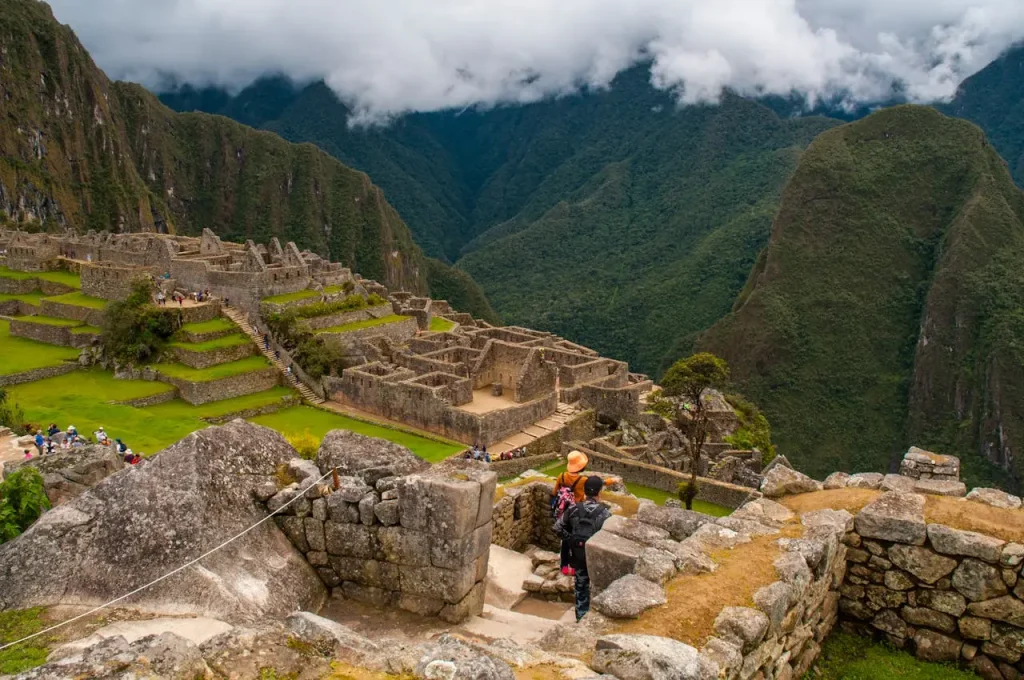
Why Are There Different Machu Picchu Circuits?
Since 2019, Peru’s Ministry of Culture implemented a circuit system to help regulate access to Machu Picchu. The reason? To protect the archaeological site from the increasing number of visitors and, at the same time, offer a more organized and enjoyable experience.
Each circuit has specific routes, set schedules, and different levels of physical demand. Some are designed for in-depth explorers, while others are shorter yet impactful. Some even include adventure hikes or scenic mountain climbs.
As of June 1, 2024, the Ministry reorganized these paths into three main circuits, combining 10 routes in total, to maintain a safe and sustainable visitor experience.
Your Guide to Machu Picchu Circuits
Currently, there are three official Machu Picchu circuits, effective from June 2024 under the latest Ministry regulations. These circuits group 10 different routes, each offering a unique way to explore the Inca citadel. Some provide panoramic views from above, others focus on temples and iconic structures, while several include access to mountains like Huayna Picchu or exclusive hikes such as Inti Punku or the Great Cavern. The right circuit for you depends on your travel style, physical condition, and time of year.
Si quieres revisar el detalle completo y actualizado de todas las rutas, puedes consultar la página oficial del Ministerio de Cultura del Perú:
Consulta los circuitos oficiales de Machu Picchu aquí
Circuit 1 – Panoramic (4 routes)
Not everyone comes to Machu Picchu for the ruins alone. Some of us are here for the views the kind that stop you in your tracks and make you forget to check your phone. If you’re more into slow walks, wide landscapes, and breathing in the energy of the Andes without diving into every stone carving, this is your circuit.
Route 1-A: Machu Picchu Mountain
Let’s be honest this one’s a challenge. You’ll be climbing more than 1,600 stone steps, and they don’t go easy on you. It’s steep, it’s long, and your legs might complain halfway up. But the moment you reach the top, everything changes. The wind feels cooler. The silence is deeper. And there it is the entire valley laid out below you, with the Urubamba River twisting like a silver thread and the citadel resting quietly in the distance.
This isn’t just a hike; it’s a personal triumph. One of those memories that replay in your head long after the trip’s over. If you’re up for it, this path offers more than views. It offers perspective.
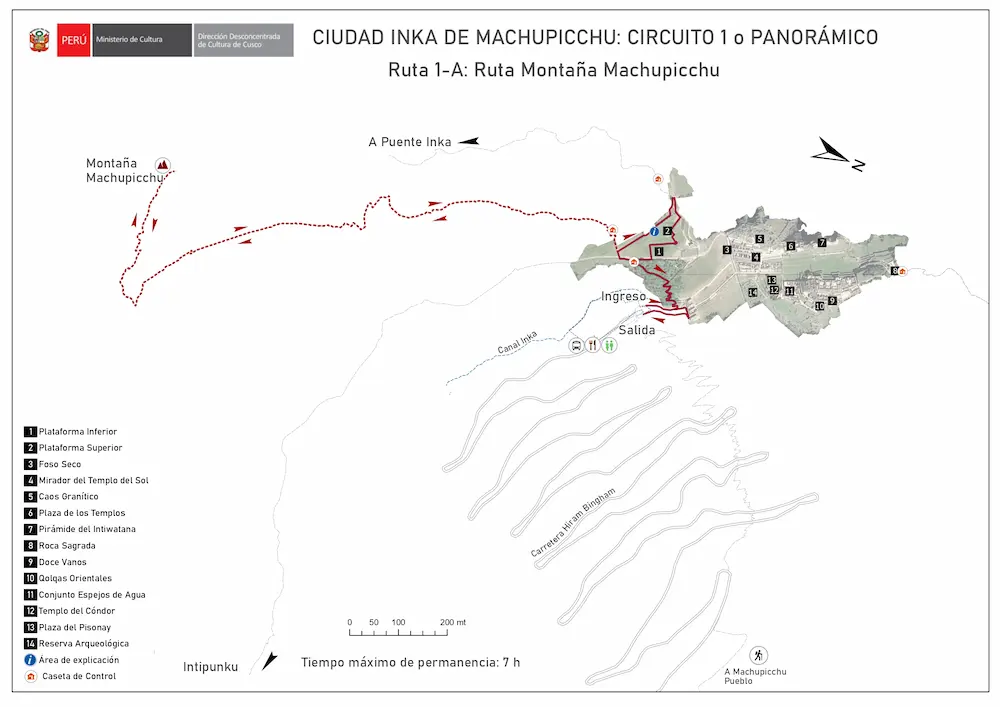
Route 1-B: Upper Terrace
If you’re looking for a calmer way to experience the beauty of Machu Picchu without pushing your limits, the Upper Terrace is a lovely option. This short and gentle walk takes you across elevated terraces that offer some of the best open views of the site perfect for soaking in the landscape without rushing.
It’s a favorite among families, older travelers, or anyone who simply wants to pause, breathe, and admire. You won’t need hiking gear or a high fitness level just a good pair of shoes and curiosity. The perspective from here is wide and peaceful. You can see the full outline of the citadel, the surrounding mountains, and if you’re lucky, a few llamas grazing nearby.
This spot is also ideal for those who love photography or quiet moments. Whether you’re visiting with kids, with parents, or on your own, this route invites you to slow down and just enjoy being there which, in a place like Machu Picchu, is more than enough.
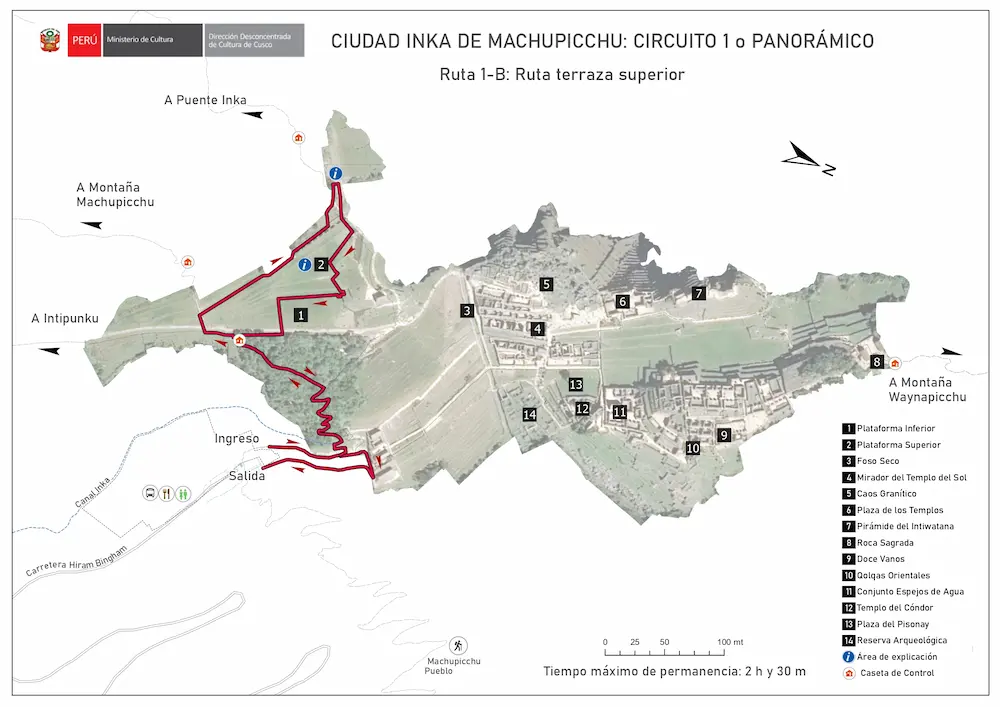
Route 1-C: Inti Punku (Sun Gate)
For many travelers, reaching Inti Punku the Sun Gate feels less like checking off a route and more like arriving at something sacred. This trail is only open during the high season, when the weather is kind enough to let the mountains show off a little.
The hike itself takes about two hours round trip and is considered moderate manageable, but you’ll feel it. What makes it worth every step is what awaits at the end: a wide stone gateway that once served as the main entrance to Machu Picchu for those coming via the Inca Trail. But what truly makes it unforgettable is the light. If you time it right and arrive early, you’ll see the first rays of sun pouring over the peaks, slowly revealing the citadel below. It’s quiet. It’s golden. It feels like something out of another time.
This route is perfect for those who want more than just a view they want a moment. And Inti Punku gives you that, in the most unforgettable way.
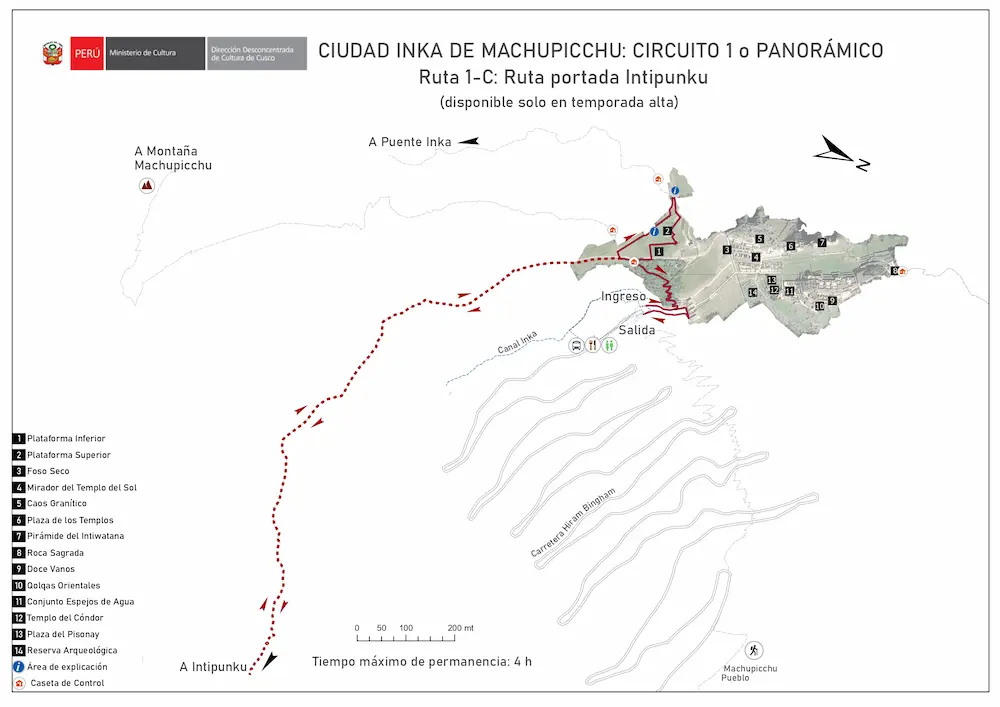
Route 1-D: Inca Bridge
This is one of those short walks that leaves a lasting impression. Open only during the high season, the route to the Inca Bridge doesn’t take long but the experience stays with you much longer than expected.
The trail hugs the edge of the mountain, winding gently through stone paths and lush vegetation. It’s not physically demanding, but it does give you that quiet sense of wonder as you realize you’re walking the same path carved out by the Incas centuries ago. And then, almost suddenly, the bridge appears built directly into a sheer cliff face. It’s simple, yet stunning. A blend of engineering and courage that defies time.
Among all the Machu Picchu circuits, this one stands out for its intimacy. It’s not about big crowds or sweeping views, but about connecting with something quiet and powerful. If you’re someone who enjoys small details, ancient secrets, and the feeling of being alone with history, the Inca Bridge route is something you shouldn’t skip.
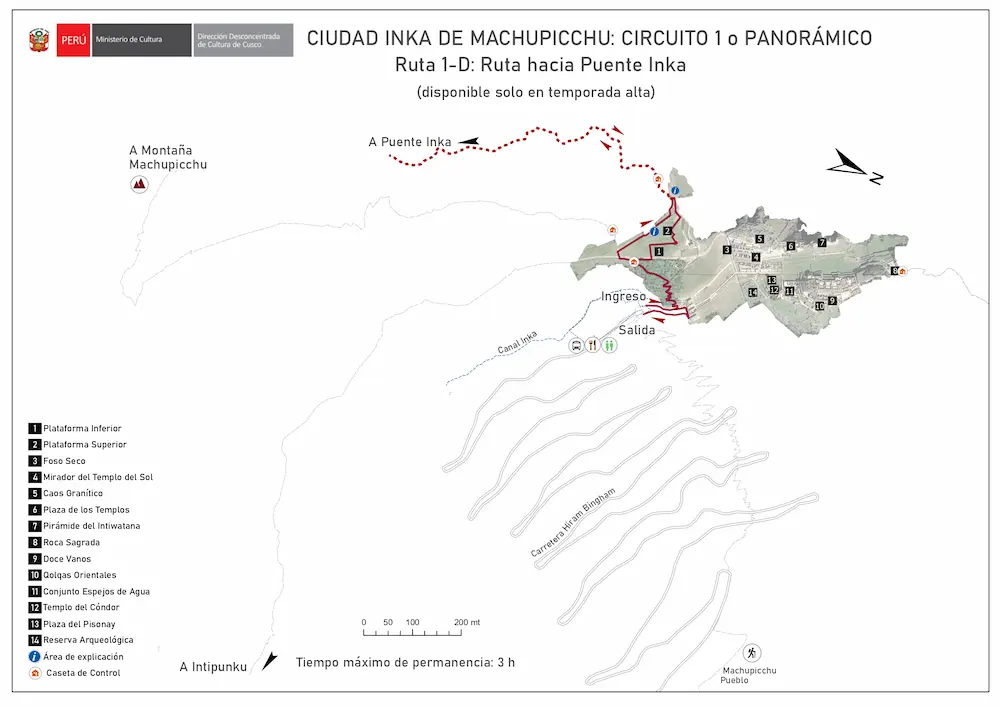
Circuit 2 – Classic Machu Picchu (2 routes)
This is the kind of route that feels like walking through a memory even if it’s your first time there. You’re not rushing, you’re not climbing mountains. Instead, you’re slowly making your way through the core of Machu Picchu, where the stone walls feel close, the terraces stretch out beside you, and the silence says more than any guide ever could.
Of all the Machu Picchu circuits, this one is perhaps the most iconic not because it’s difficult or remote, but because it brings you face to face with the essence of the citadel. Here, you feel part of it.
Route 2-A: Standard Route
It’s not just a walk it’s a path full of presence. You’ll pass through the Temple of the Sun, where the light seems to fall with purpose. Then come the Three Windows, framing the mountains like a painting. And just when you think you’ve seen enough, there’s the Sacred Rock still, massive, and strangely comforting.
It’s less about taking photos and more about letting the place speak. Slowly. Quietly. Until you realize: this isn’t just a ruin. It’s a story you’ve stepped into.

Route 2-B: Lower Terrace
Not every visit to Machu Picchu has to involve climbing or long hours on your feet. Sometimes, what stays with you the most are the quiet paths the ones that let you breathe, look around, and simply take it all in. That’s what the Lower Terrace route offers: a softer, gentler way to experience the magic.
This path gives you a broad, open view of the terraces below and around the citadel. You’re not surrounded by temples or tight alleys instead, you find yourself walking alongside the agricultural areas that once fed an entire city. The openness here makes it perfect for travelers who want to move slowly, take wide-angle photos, or just sit and admire the incredible engineering of the Incas.
If the Standard Route is a dive into the spiritual and ceremonial core, the Lower Terrace is a reminder of how grounded and practical life here really was. It’s a lighter route, yes, but no less meaningful.
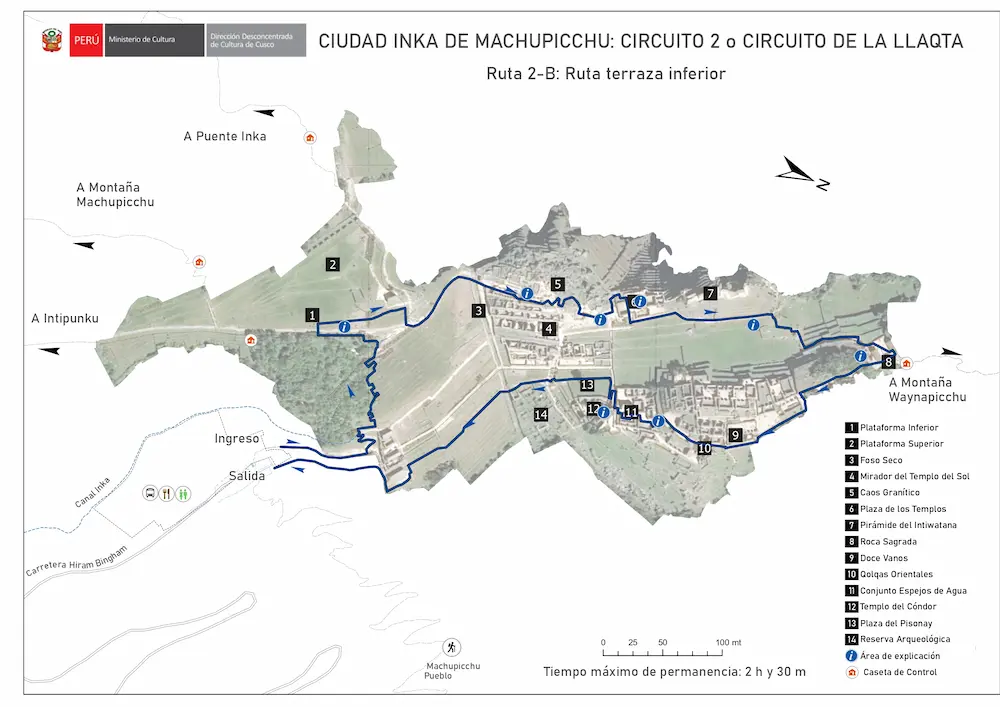
Circuit 3 – Royal Machu Picchu (4 routes)
This circuit is for those who want more not just more time on the trail, but a deeper look into the quieter corners of the citadel. It’s more demanding, yes, but it also opens doors to parts of Machu Picchu that few take the time to explore. If you’re curious about the noble sectors and hidden places beyond the usual photos, this path might be what you’re looking for.
Route 3-A: Huayna Picchu Mountain
This is one of the most talked-about hikes in all the Machu Picchu circuits, and for good reason. Climbing Huayna Picchu isn’t easy the steps are steep, narrow, and constant. It takes about three hours round-trip, and you’ll feel every minute of the climb. But once you’re up there, the view is something else entirely. The entire citadel spreads below you, like a model carved into the mountainside.
The route starts with access to Machu Picchu itself before heading up the mountain. And for those who want to go even further, there’s the option to extend the hike to the Great Cavern a lesser-known site that adds about another hour. It’s a trail for those who want the adventure and are ready to earn every bit of it.
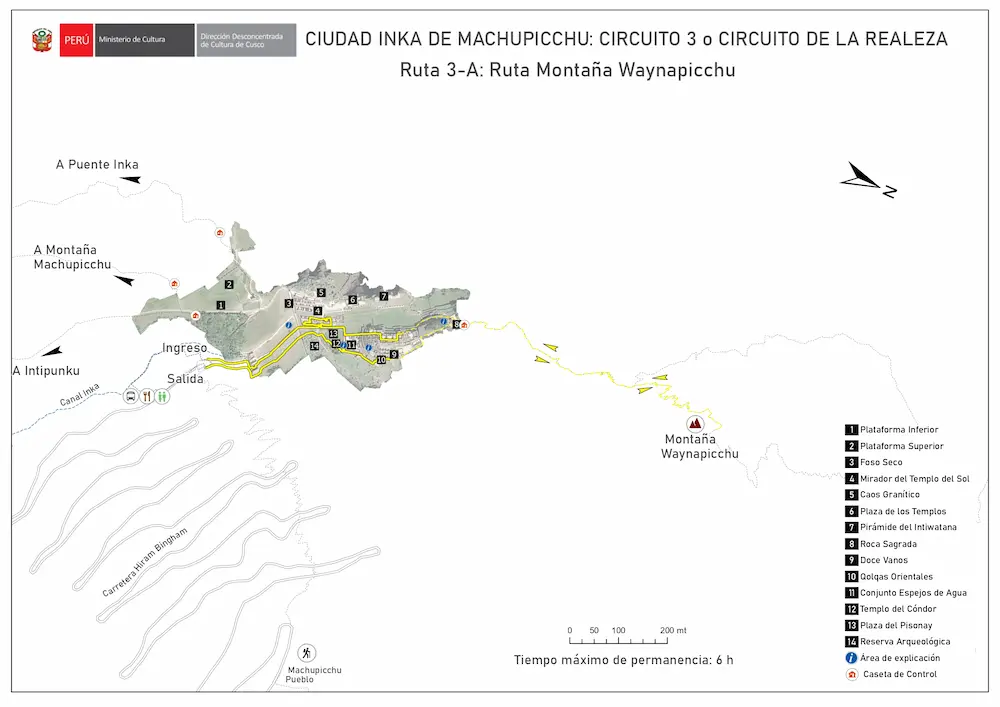
Route 3-B: Royal Design
This route doesn’t ask much from your legs, but it says a lot to anyone paying attention. You won’t be climbing steep paths or reaching high lookouts instead, you’ll find yourself walking through the kind of places that make you stop and wonder how the Inca lived their daily lives.
You’ll pass by the old qolqas, which were storage buildings and to be honest, they still look sturdy enough to be used today. The layout feels practical, thought-through. Then there’s the Inca House, which honestly catches you off guard. It’s not just another ruin the cuts in the stone are too precise, almost like they were carved yesterday. There’s something in the silence around it that feels respectful.
And then there’s a small surprise: the water mirrors. Two carved basins that, under the right light, reflect the sky so clearly you might mistake them for something modern. But they’re not. They’re ancient, quiet, and kind of beautiful.
This isn’t the flashy route. It’s the thoughtful one. The one where less happens and somehow, that makes it more memorable.
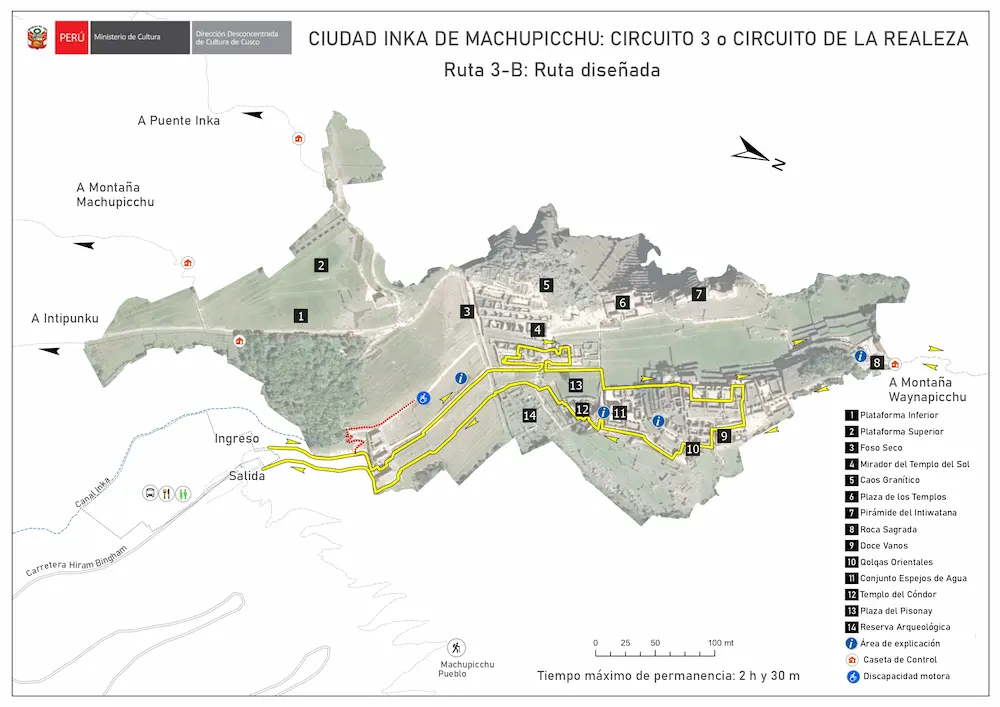
Route 3-C: Great Cavern (high season only)
This isn’t a route you stumble across you have to really want to go there. The path to the Great Cavern is only open during the high season, and even then, it’s not the most visited. But maybe that’s part of the appeal.
It’s an extension of the Royal Circuit, and it takes you deeper into a less-explored corner of the site. The trail is quiet, a bit longer, and there’s a sense that not many people walk it which makes reaching the cavern feel oddly personal. When you arrive, you don’t find a grand chamber, but rather a carved space that clearly mattered. It’s subtle. Mysterious. You get the sense that this place had a purpose, even if no one tells you exactly what it was.
Among the different Machu Picchu circuits, this one feels like a hidden chapter. Not dramatic, but quietly powerful the kind of place that doesn’t shout, but stays with you for reasons you might not fully explain.
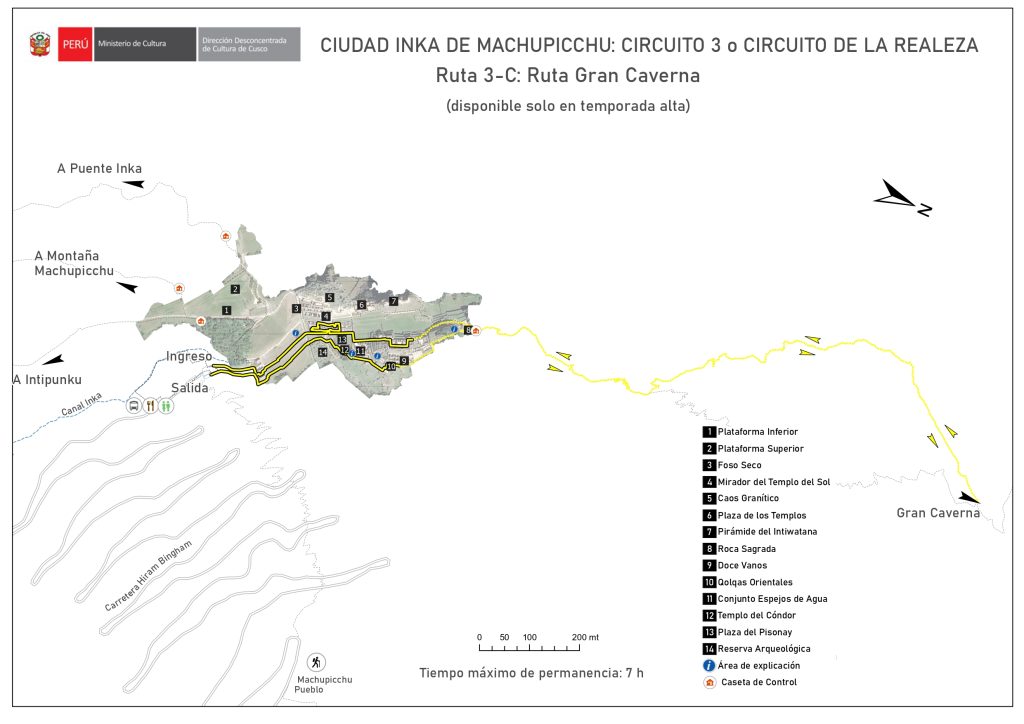
Route 3-D: Huchuy Picchu (high season only)
If you’re looking for a shorter, quieter hike that still gives you something special, Huchuy Picchu might be exactly what you need. It doesn’t take long to reach the top maybe 30 to 45 minutes but that’s not what makes it interesting.
The trail itself feels tucked away. Most people don’t even realize it’s there. It starts off gently, with narrow steps carved into the hillside, and pretty soon you find yourself rising above the edge of the site. When you reach the viewpoint, it’s not the wide, dramatic postcard angle. It’s something else something more personal.
You see Machu Picchu from a slightly different angle, closer than you’d expect, and somehow more alive. The crowds feel distant, the noise fades, and for a moment, it’s just you and the mountain. No filters. No rush.
It’s one of those places that doesn’t need a big explanation. You go, you see, and something about it stays with you. Sometimes, the smallest routes offer the clearest moments.
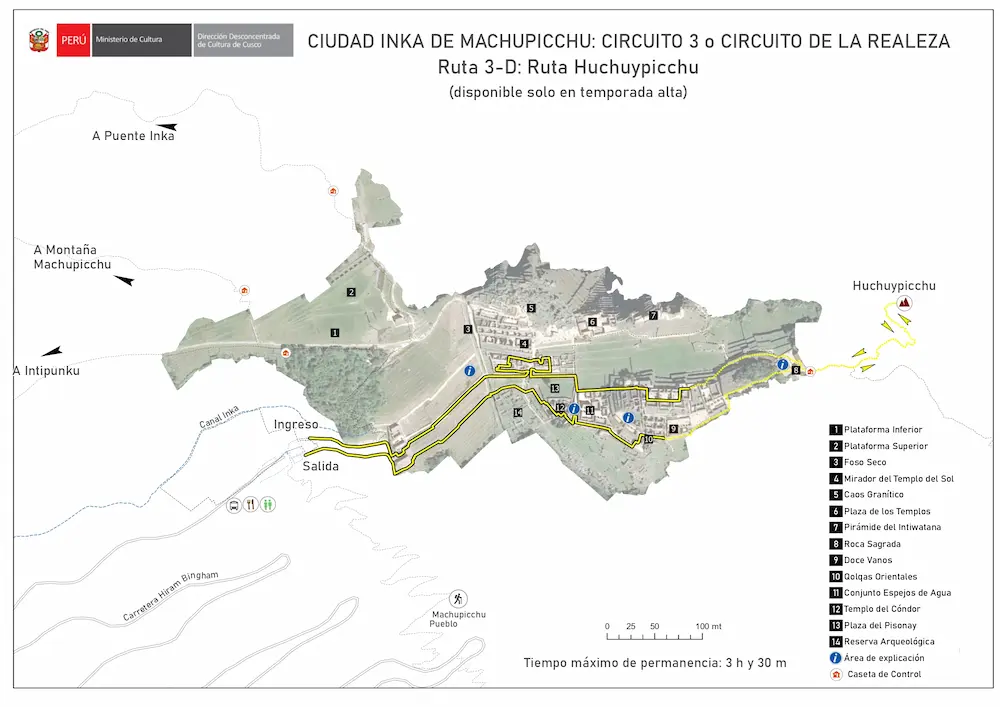
Which Mountain to Choose at Machu Picchu?
Besides the citadel tour, you can climb one of three mountains, each offering a distinct experience. Your choice depends on fitness level, interests, and desired intensity. Choosing the right one also depends on which of the Machu Picchu circuits you book, as each circuit grants access to different trails.

Huayna Picchu (Waynapicchu)
That famous peak behind Machu Picchu in the postcard view. Climbing it is intense and thrilling.
- Highlights: Aerial views of the citadel, mysterious Inca structures at the summit.
- Difficulty: High—steep stairs, narrow paths, rope sections.
- Duration: 2–3 hours round trip.
- Important: Limited to 200 visitors/day. Book months in advance through the appropriate Machu Picchu circuits.
Machu Picchu Mountain
Higher than Huayna Picchu and less crowded.
- Highlights: Panoramic views of the sanctuary, Urubamba River, and surrounding jungle mountains.
- Difficulty: Moderate to high.
- Duration: 3–4 hours round trip.
- Ideal for: Hikers, landscape photographers, and peace seekers.
Huchuy Picchu
A shorter, easier climb.
- Highlights: Direct view of the citadel with minimal effort.
- Difficulty: Low.
- Duration: 45 minutes to 1 hour.
- Perfect for: Families, seniors, or anyone short on time.
You may also like: Festivities in Peru, celebrations for the second half of 2025
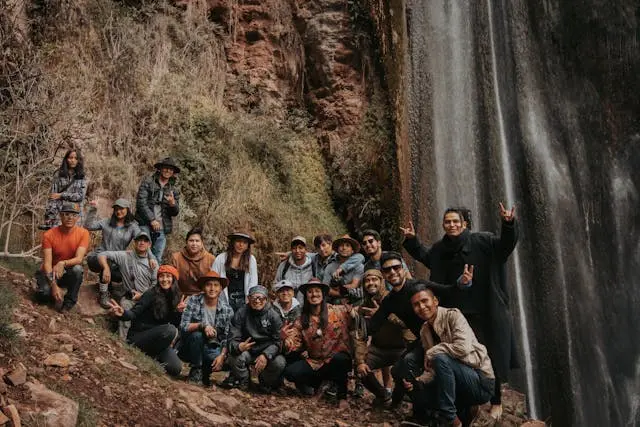
What to Wear to Machu Picchu by Season
Machu Picchu sits over 2,400 m.a.s.l., with weather that shifts by the hour. Packing wisely can make or break your experience especially depending on which of the Machu Picchu circuits you choose. Some circuits involve longer hikes and panoramic viewpoints, while others focus on archaeological areas with more shade or stone paths.
Dry Season (April to October)
Most popular time, with clear skies and cool mornings.
Bring:
- Breathable long-sleeve shirts
- Convertible hiking pants (avoid jeans)
- Fleece or light jacket for mornings/evenings
- Wide-brimmed hat and sunglasses
- Sunscreen
- Broken-in trekking shoes
Extra tip: Pack a light windbreaker just in case weather changes quickly at viewpoints, especially along Machu Picchu circuits that include high-altitude stops like Machu Picchu Mountain or Inti Punku.
Rainy Season (November to March)
Expect showers, mud, and fewer crowds. Everything’s greener!
Bring:
- Waterproof jacket or poncho
- Quick-dry clothes (avoid cotton)
- Spare socks (in a plastic bag)
- Backpack with rain cover
- Water-resistant hiking pants
- Rubber-tipped trekking poles (optional)
Extra tip: Use grippy shoes and ziplock bags for your phone, passport, or tickets. This is essential for wet-weather Machu Picchu circuits, especially those that involve steps or narrow trails.
All year:
- Refillable water bottle
- Light snacks
- Wet wipes or TP
- Small, comfy backpack (large bags not allowed)
How Far in Advance Should I Buy My Ticket?
- Circuits 1, 2, 3: 2 weeks in advance (low season), 1–2 months ahead (high season).
- With Mountain Access: Book 2–3 months ahead. Spots fill up fast.
How Long Is the Trip from Aguas Calientes to Machu Picchu?
- Bus: 30 minutes. Departures every 10–15 mins from 5:30 a.m.
- Hike: 1.5 to 2 hours via stone steps. Moderate to high effort.
Important Recommendations
- Always carry your passport and entry ticket (printed or digital).
- No re-entry once you leave the archaeological site.
- Metal poles, snacks, or drones are not allowed.
- Follow marked routes and listen to certified guides if you take one.
You may also like: Learn to distinguish the differences between llama and alpaca
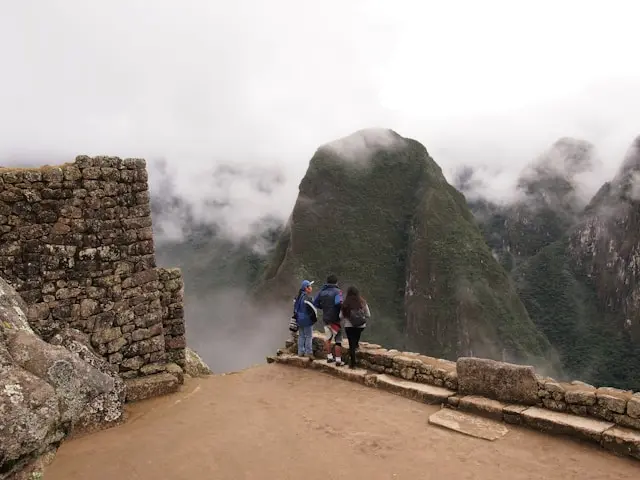
Which Machu Picchu Circuit Is Best for You?
First time in Machu Picchu? Go with Circuit 2.
It’s the most balanced option not too long, not too steep, and it covers the key areas you’ve probably heard about: the temples, the main plaza, and that classic viewpoint. If you’re not sure where to start, this one won’t let you down.
Looking for unforgettable views? Circuit 1 or Machu Picchu Mountain is your path.
Circuit 1 includes panoramic routes with wide, open landscapes perfect if you want to take in the site from a distance. And if you’re up for a hike, Machu Picchu Mountain gives you some of the most incredible views over the whole valley. It’s not easy, but the scenery at the top is something you’ll remember for years.
In it for the challenge? Try Circuit 3 with Huayna Picchu.
This one’s for people who like to earn their view. The hike up Huayna Picchu is steep and narrow, but it rewards you with dramatic angles and a unique sense of perspective. Add the Great Cavern to the route if you want something even more off the radar.
Prefer something short and easy? Stick with Circuit 3 or Huchuy Picchu.
Not every visit has to be intense. Huchuy Picchu is a gentle climb to a quieter viewpoint a nice alternative if you want the experience without pushing too hard. And some parts of Circuit 3 give you a good sense of the site without the effort of the bigger climbs.
Frequently asked questions about Machu Picchu circuits
Choosing between the different Machu Picchu circuits can be a bit overwhelming, especially if it’s your first time visiting. To help you plan with more confidence, here are some of the most common questions travelers ask answered in a simple way so you know what to expect before you arrive.
Which of the Machu Picchu circuits is best for first-time visitors?
Honestly, Circuit 2 is a safe and balanced choice. You get temples, plazas, and great views kind of a bit of everything. If it’s your first time and you don’t want to overthink it, that one covers the essentials.
Can I do more than one circuit on the same day?
Nope that’s one of the strict rules. One ticket gives you access to just one circuit and at a specific time. If you’re hoping to explore more than one of the Machu Picchu circuits, you’ll need to buy a separate ticket.
Where can I get the classic postcard view of Machu Picchu?
That iconic view you’ve probably seen online? You’ll catch it best on Circuit 2-A or 1-B. Those routes go through the upper terraces, which open up to the entire citadel. It’s one of the highlights of the circuits for photographers.
Are all the Machu Picchu circuits difficult to hike?
Not at all. Some are more demanding, like the hike to Huayna Picchu in Circuit 3. But others, like Route 1-B or 2-B, are much gentler and better suited for travelers who want the experience without the workout.
Do I really need a guide to explore the circuits?
Technically, you can go without one. But a guide gives you way more context stories, history, even small details you’d probably miss otherwise. Especially if you’re choosing one of the more in-depth Machu Picchu circuits, it’s worth it.
Final Thoughts
Machu Picchu isn’t just a place it’s an experience. It’s living history, Andean energy, and a tribute to our ancestors’ brilliance. Walking through its terraces, temples, and trails isn’t just tourism it’s a soulful journey.
Understanding the Machu Picchu circuits lets you enjoy the site your way whether you’re chasing landscapes, immersing yourself in sacred spaces, or soaking in the mystical vibe.
Plan ahead, study your routes, and consider the weather. Get ready to walk, to climb, and to pause often in awe. Bring the right clothes, water, sunscreen, and above all, a mindset of respect and wonder.
Because yes, even if you’ve seen a thousand photos, being there changes everything.
So… which circuit will you choose?
Your journey to Machu Picchu starts now.
